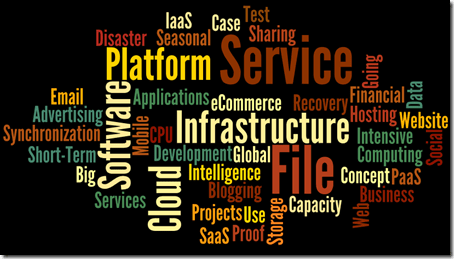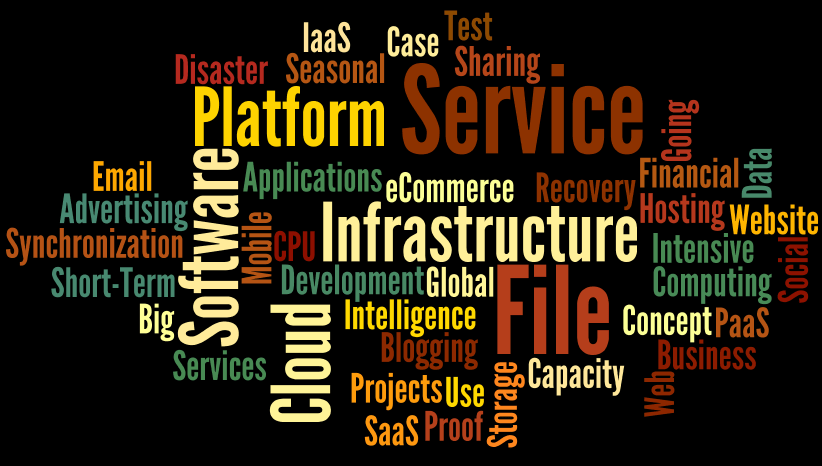Cloud computing is established. And it has been proven by small and large businesses alike. Over the past 5 or so years, I have seen all types of companies adopting cloud computing as both primary and secondary sets of on-demand compute. Some cloud computing use cases are pretty traditional (e.g., a simple web presence) while others become extremely complex and complete edge-cases (think Netflix).

Where do all of these companies fit in with their use of the cloud? I won’t talk to the edge-cases simply because they are often too complex or too niche-oriented (might be an interesting article though…the most unique cloud computing use cases). However, I do believe that going through some of the most commonly found scenarios can spark interest and ideas, especially for those businesses who haven’t moved to the cloud yet (what are you waiting for, by the way?).
From first-hand experience working at a cloud infrastructure provider as well as from regular scouring of industry news, I have compiled a list of the 15 Top Cloud Computing Use Cases. But before I go into these, I want to sidetrack just a bit. I have long talked about the 3 layers of cloud computing: Infrastructure, Platforms and Applications. I would be completely missing an opportunity if I didn’t talk about Cloud Platforms (PaaS) and Cloud Applications (SaaS). These are two important use cases to think about broadly, especially that of SaaS – Software as a Service. While Platforms as a Service could potentially utilize Infrastructure as a Service as their foundation, I have found that many PaaS environments tend to be built directly from bare metal infrastructure as opposed to using Cloud Infrastructure. SaaS, however can much more easily be built and powered by Cloud Infrastructure. So there’s your first use case – SaaS – using clouds to power clouds.
Assuming you are not a SaaS developer or provider, what can cloud computing do for your business? And where, if you are starting a business, are in the planning stages or looking to get a project off the ground within your organization, are you going to host your success? I have an answer. Think cloud.
Below is a list of the most common cloud computing use cases that I have come across. The list is not in any particular order. If you have other use cases or ways you are using cloud at your business, please leave a comment.
15 Top Cloud Computing Use Cases
- File Storage, Synchronization & Sharing – Everyone has heard of Dropbox, Box.net, Google Drive and even Bitcasa , right? These are file storage and synchronization services. Some provide limited storage while others are limitless. They scale (as typical clouds do) and they are on-demand and accessible via the Internet (more cloud characteristics). Many are consumer grade, however SMBs and corporations use enterprise-grade cloud storage which helps organizations centralize their data and files.
- Email – This is the classic SaaS application which has been around for years. From Gmail to Outlook.com , consumers (and businesses) access this service via the Internet as well. Clearly an obvious and established use case, I felt compelled to include it despite its age.
- Blogging – There are plenty of blogging platforms out there. To me, the hosted blogging service somewhat falls into the Platform play. However, when you move to self-hosted blogging platforms, you seem to move away from the multi-tenancy. That cleanly leads to the next use case…
- Website Hosting – This is one of the most common business-oriented uses of cloud computing. While companies can host their web presences on physical servers or single cloud servers, the true scale and ability to grow comes when these business start enabling transactions or other web-based services within their hosted environments. If they are built in the cloud, they are prepared to scale and grow based on demand.
- Disaster Recovery – Recently, this use case has become more prevalent for a number of reasons, I believe. For starters, setting up environments within the cloud has become much easier. Also 3rd parties are enabling redundancy and failover services as cloud computing matures. As opposed to traditional physical infrastructures which sit idle waiting to be “called into action,” cloud disaster recovery or failover environments can stand by as environments in “saved” states in the form of machine images, or they can be as hot standbys, meaning they contain live replicated files and data. We all know that hardware fails and people make coding mistakes, the cloud enables you to be ready to respond, even automagically!
- Going Global – With traditional data centers, you typically select a physical location to best service your customers. But the web is global as is your audience. Many (not all) cloud providers are global with data centers around the world. This means that you can set up multiple presences to better localize your content, services or products. I know of companies overseas that are servicing a primarily US audience. So, while the HQ might be in Australia, their cloud presence is spread across the United States.
- Test and Development – A couple of the niceties of the cloud is not only its immediacy but also how infrastructure or environments can be built up, tested and torn down quickly. Want to see how your application performs under load? Create a clone of it and load test it. Then “throw it away” when you are done with your testing. Wondering how an Ubuntu server environment performs compared to Windows Server? In minutes you can build up both and test side-by-side, then dispose of the one that you don’t want.
- Short-Term Projects – Similar to test and dev, the cloud offers great tools for those short-term projects. Say you need a simple web presence or micro-site for a couple of months. You can easily stand one up in the cloud, use it during that period, then tear it down (and save it potentially for later use) when you are done. Also, projects that have a short runway can immediately find success in deploying cloud environments simply because you can be up and running in minutes/hours as opposed to days/weeks with traditional hardware requisitioning.
- Proof of Concepts – Do you have an idea that you just want to try out? Perhaps you are a boot-strapped startup that wants to prove that your idea is a sound one to your potential investors. Instead of having to plunk down precious money as a capital expenditure, for significantly less, you can put your idea or concept in the cloud and see if you get the traction you are hoping for. If you follow the “build it and they will come” mantra, then cloud is for you. Just say no to that server in the back of your garage. There isn’t much reliability or performance with that route.
- Seasonal Capacity – Scalability is, as I have said, one of the biggest advantages to using the cloud. If architected properly, you can set up a multi-tiered environment that has elasticity in the front-end (e.g., the web and application servers) while putting your larger database servers in a protected back-end. When you need capacity to meet the demands of your end users, you scale out that web/application server layer and when the need subsides, you scale it back. That way, you don’t leave any infrastructure under-utilized (that can get expensive).
- Business Intelligence/Big Data – I’m combining these two use cases. As more products and services are created and more users engage with these items, more information is gathered from and about them. Businesses are turning towards analytics, business intelligence and Big Data to find out more about their prospects and their customers. As the data grows, so must the environment that captures and analyzes it. Since the cloud is scalable, it’s a perfect partner for Big Data, analytics and BI. Often, the cloud is used as the presentation layer for the results of analysis.
- Web, Social & Mobile – It seems like there is a new social service or aggregator of social content or mechanism to nurture communities being announced every week. And more often than not, these environments and services are being stood up in the cloud. If the service or offering succeeds, it can be scaled. If it fails, it can be easily shut down. All of this without much of a capital expenditure. As there is a convergence of web and mobile, meaning companies should always think about their mobile presence as more and more consumers use smartphones to access sites and services, the cloud overs a perfect platform for these multi-access environments.
- Advertising – Advertising frequently is headless, that is to say, ads are dispersed yet centrally managed behind the scenes by a “mother ship.” It is becoming more frequent to have these advertising central servers to be hosted regionally in the cloud (and often, they are coupled with Contend Delivery Network – CDN – services). Used in conjunction with Big Data, advertising companies have become more agile by using the cloud as their primary compute and storage resource.
- CPU Intensive Applications – One of the beauties of using the cloud is the immediate access to high performance compute consumed on a short term basis. Large quantities of data (think social media or health care or advertising) can be crunched using high-performance cloud environments. What traditionally would take weeks or more to requisition, stand up, configure and use, now can take days or even hours, especially if these cloud environments are saved for future use, and the resulting costs are a fraction of what traditional environments would be. This use case was one of the first to be showcased when cloud first started gaining traction.
- Financial Services/eCommerce – Coupled with website hosting and Big Data is the eCommerce overlay. Companies want to make money and the best way to do this is to shopping-cart enable their product or service offering. And, as more and more businesses and consumers look to the web to manage their financial data (and that data continues to grow), the cloud offers that scalable benefit. While security is often cited as a concern, the cloud (depending on the vendor) is more secure than self-managed data centers and compliance concerns are being met head-on by architecting private cloud or hybrid cloud environments where user data (financial or personal) is heavily firewalled and secured away from a cloud front-end.
Many of the use cases described above can be used in conjunction with traditional hardware environments, but I would happen to guess that after seeing the capability of the cloud and the potential cost savings and flexibility, many older infrastructure installments might be phased out in favor of pure cloud architectures.

Where is your business? Does it fall into any of the cloud computing use cases listed above? How will you be using the cloud to succeed? Leave a comment and let me know.

HTD says: What are you waiting for? The cloud is here waiting to help your business succeed!



6 comments
Annoyed Guest
It’s annoying to have a video start playing every time you open the page.
hightechdad
Sorry that you feel that way. This site does have to monetize in some way. You can simply pause the playback on the page.
Drupal Development
The topic is so interest and so nice useful too..Thanks for sharing this post.
Susan Bilder
This is definitely a great promotion for cloud computing. Clearly, there are many ways that the cloud is already being used and the possibility for the future is endless.
Alexander Brown
I already connected with Cloud People (http://www.cloudpeople.com.au/) providing high performance services.
Scott Beisner
I nominate us (SST-ShotSpotter) for “the most unique cloud computing use case” article.